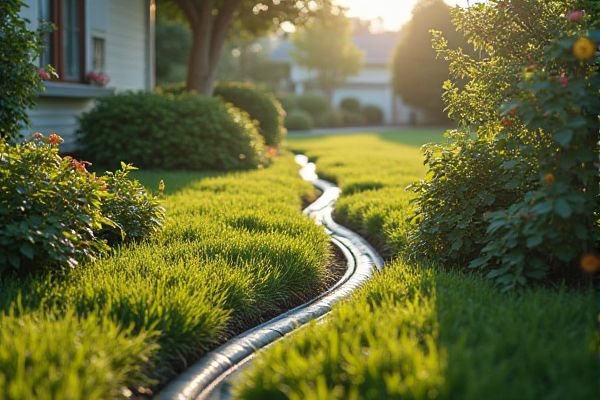
Soaker hoses deliver water evenly along their porous surface, making them ideal for watering dense garden beds, while drip tubes provide targeted, precise irrigation directly at the base of plants, minimizing water waste. Explore the rest of the article to discover which watering solution best suits your garden's needs and enhances your irrigation efficiency.
Table of Comparison
| Feature | Soaker Hose | Drip Tube |
|---|---|---|
| Water Delivery | Water seeps through porous material along entire hose length | Water drips from emitters spaced along the tube |
| Water Efficiency | Moderate water efficiency, some runoff possible | High water efficiency, precise water application |
| Installation | Easy to install, lay on soil surface or under mulch | Requires emitters and precise placement, slightly complex |
| Maintenance | Occasional flushing to avoid clogging | Regular checks, cleaning or replacement of emitters needed |
| Ideal Use | Garden beds, shrubs, uniform watering areas | Container plants, row crops, targeted watering zones |
| Cost | Lower initial cost | Higher initial cost |
| Durability | Moderate, prone to damage and clogging | Higher durability with quality tubing and emitters |
Introduction to Soaker Hose and Drip Tube Irrigation
Soaker hoses and drip tubes are efficient irrigation tools designed for targeted watering of plants, reducing water waste and promoting healthier growth. Soaker hoses release water through porous material along their length, perfect for evenly hydrating garden beds, while drip tubes deliver precise water drops directly to plant roots with adjustable emitters. Choosing the right system depends on your garden layout, plant types, and water conservation needs to optimize irrigation efficiency.
How Soaker Hoses Work
Soaker hoses work by releasing water slowly through tiny pores along their length, allowing moisture to seep directly into the soil and reach plant roots efficiently. This method reduces water evaporation and runoff compared to traditional sprinklers, ensuring deep soil penetration. Soaker hoses are ideal for garden beds and densely planted areas where uniform watering is essential.
How Drip Tubes Function
Drip tubes function by delivering water directly to the root zone of plants through small emitters spaced along the tubing, ensuring efficient moisture distribution with minimal evaporation. This targeted watering method conserves water and reduces runoff compared to traditional garden hoses or soaker hoses. Your plants benefit from consistent hydration, promoting healthier growth and reducing water waste.
Water Efficiency: Soaker Hose vs Drip Tube
Drip tubes deliver water directly to the plant roots with minimal evaporation, offering superior water efficiency compared to soaker hoses, which release water along the entire length and can lose moisture to the surrounding soil surface. Soaker hoses can be less precise, leading to potential overwatering or runoff, whereas drip tubes allow for targeted irrigation, conserving water by delivering it exactly where your plants need it. Choosing drip tubes enhances your garden's water management by reducing waste and promoting healthier root zones.
Installation Process Compared
Soaker hoses are simpler to install, requiring only connection to a water source and placement along garden rows, making them suitable for quick setup. Drip tubes require more precise placement and often need emitters or connectors to regulate water flow, demanding a more involved installation process. Both systems benefit from using timers and pressure regulators to optimize watering efficiency.
Maintenance Requirements for Each System
Soaker hoses require regular flushing to prevent clogging and occasional inspection for leaks due to their porous nature, while drip tubes demand consistent cleaning of emitters to maintain optimal water flow and prevent blockages. Both systems benefit from seasonal maintenance such as removing debris and checking pressure regulators to ensure efficient irrigation. Proper upkeep extends the lifespan of each system and promotes healthy plant growth by delivering water evenly.
Cost Analysis: Upfront and Long-term
Soaker hoses generally have a lower upfront cost compared to drip tubes, making them more budget-friendly for initial installation. However, drip tubes offer better water efficiency and durability, potentially reducing long-term water bills and replacement expenses. Investing in drip irrigation systems can lead to greater savings over time despite the higher initial investment.
Best Uses and Applications
Soaker hoses provide even water distribution ideal for watering garden beds, shrubs, and closely spaced plants, making them perfect for vegetable gardens and flower borders. Drip tubes deliver targeted watering at the root zone, which minimizes evaporation and runoff, best suited for container plants, row crops, and plants requiring precise irrigation. Choosing between soaker hose vs drip tube depends on your garden layout and plant water needs to optimize water efficiency and promote healthy growth.
Pros and Cons of Soaker Hoses
Soaker hoses provide efficient water delivery directly to plant roots, minimizing evaporation and runoff, making them ideal for garden beds and established plants. They are easy to install and cost-effective but may suffer from uneven water distribution and can clog if not properly maintained. Compared to drip tubes, soaker hoses are less precise in water delivery but offer broader coverage for dense plantings.
Pros and Cons of Drip Tubes
Drip tubes offer precise water delivery directly to plant roots, minimizing water waste and reducing evaporation compared to soaker hoses. Their flexibility allows customization for diverse garden layouts and plant types, but they can clog easily without proper filtration and require higher initial installation effort. Maintenance demands and susceptibility to damage from garden tools or UV exposure are notable drawbacks compared to the more durable soaker hoses.
 homyna.com
homyna.com